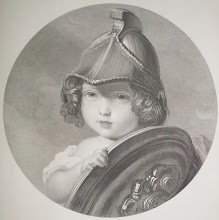In among a box of second-hand books bought from a North London dealer in the late 1970s was a thick international railway timetable.
So boring did this tome appear to be that the seller apparently missed the eight small etchings hidden between the pages — a mistake that, in effect, handed the buyer a small fortune when they were identified three years ago as unique works by the visionary artist and writer William Blake.
Tate galleries have now bought these brilliantly executed and disturbing pictures for £441,000 and will exhibit them at Tate Britain in July.
They are not the sort of images that are likely to be ignored again. In one a naked man screams in horror as flames rage around him. In another a figure with long hair bends over a glowing red pool. Blake’s caption reads: “vegetating in fibres of blood”.
Alison Smith, curator of British Art up to 1900 at Tate Britain, said: “They are the best of what Blake produced [as an artist]. They are only inches across but they are so expressive and powerful that they suck you into this tormented world.”
Partly this visceral effectiveness is due to Blake’s distinctive compositional style, with his tortured subjects “pushed right up against the frame of the picture”, Ms Smith said. Partly it is the terse captions such as the one beneath a picture of a drowning figure that reads “the waters overwhelmed me”, making the experience of looking at it an uncomfortably personal one.
Most of all though it is the strength of the images, dredged from Blake’s imagination, which makes them look strikingly modern when set against the subject matter of his more successful peers, Constable and Turner.
Today Blake is regarded as one of the greatest of British artists but his contemporaries, with few exceptions, either ignored him or dismissed him as a madman.
Born in 1757 he had most success in his lifetime as a commercial engraver of other people’s work. The original writings and artwork that are now held to be proof of his genius were known to only a few. His one shot at fame, a solo exhibition in his brother’s hosiery shop in Soho in 1809, attracted a single critic who dismissed the work as “wretched pictures... the wild effusions of a distempered brain”.
However, Blake always believed that posterity would recognise his greatness and despite a constant struggle for money he remained a prolific chronicler of his own visions and dreams until his death at 69 in 1827. He was buried in an unmarked grave in the dissenters’ graveyard at Bunhill Fields, East London.
Tate’s new acquisitions probably date from the 1790s when Blake’s radical imagination was stirred by the potential of the French Revolution and he had begun to produce the series of illuminated prophetic books for which he is best known, using a secret printing technique that he invented.
At least one patron, his friend Ozias Humphrey, commissioned Blake to produce separate prints of his favourite illustrations from these books. Humphrey’s collection of 23 prints is known today as Copy A of the Small Book of Designs and held at the British Museum.
Six of the eight etchings were first seen in The First Book of Urizen. One is from the mythological poem The Book of Thel and the other is from the revolutionary prose work The Marriage of Heaven and Hell. Blake finished the prints with pen and ink and hand-coloured them by layering tempera on watercolour, to create what Ms Smith describes as “unique and fully realised works of art”.
After Blake’s death this set of eight were among works given by his widow, Catherine, to the artist Frederick Tatham. Their whereabouts was then unknown until the anonymous second-hand book buyer brought them to Tate for authentication in 2007.
Nicholas Serota, the director of Tate, said: “This was an extraordinary find, and I am delighted we have been able to acquire it for the nation.”
